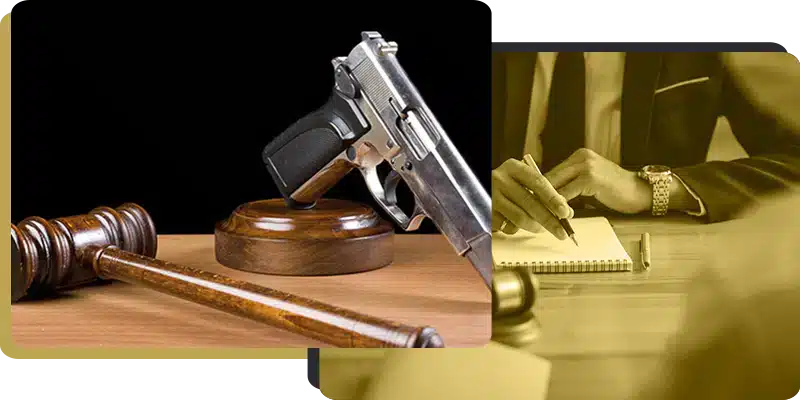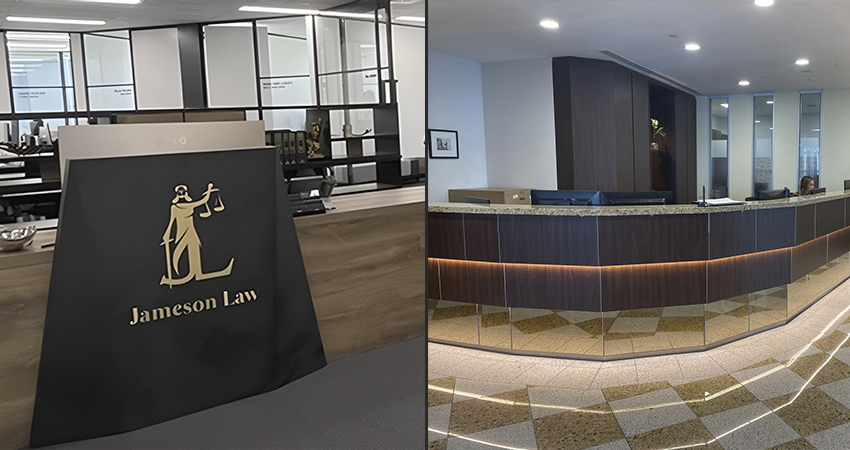PUBLIC ORDER OFFENCES
WE GET IT
WE'RE IN IT TO WIN IT
Book your consultation
- This form submission is encrypted and secured to ensure your information remains confidential.
This form submission is encrypted and secured to ensure your information remains confidential.
Our criminal law knowledge and experience is your best defence against your public order offence charge.
Award Winning Criminal Law Experts
We have won several criminal defence and client service excellence awards every year up to and including 2025.
Proven Track Record
60+ Years of combined experience defending criminal matters means a successful outcome is on the table.
5 Star Reviews Everywhere
We’re in it to win it and we fight hard for our clients. That’s why anywhere you look you will find 5 star reviews.
Easy Finance Options
Get urgent premium legal representation now and pay later with affordable fortnightly or monthly payments.
Award Winning Criminal Law Experts
We have won several criminal defence and client service excellence awards every year up to and including 2025.
Proven Track
Record
60+ Years of combined experience defending criminal matters means a successful outcome is on the table.
5 Star Reviews
Everywhere
We’re in it to win it and we fight hard for our clients. That’s why anywhere you look you will find only 5 star reviews.
Easy Finance
Options
Get urgent premium legal representation now and pay later with affordable fortnightly or monthly payments.
Public order offences are criminal offences that range in their degree of seriousness. Any criminal charge and conviction can have an ongoing impact on other areas of your life such as employment. If you have been charged with a public order offence, contact our office for an initial consultation.


What are public order offences?
Public order offences are offences that have the ability to cause be a public nuisance or a breach of the peace that results in members of the public fearing for their personal safety or the safety of their property. They can be divided into summary offences and indictable offences and some are governed by two statutory frameworks, Commonwealth and State. State statutory frameworks are covered on this page.
Summary public order offences are covered under the Summary Offences Act 1988 (NSW) and include:
![]() Offensive language
Offensive language
![]() Offensive behaviour (disorderly conduct) e.g. obstructing traffic, violent disorder, obscene exposure, etc.
Offensive behaviour (disorderly conduct) e.g. obstructing traffic, violent disorder, obscene exposure, etc.
![]() Knives and offensive implements
Knives and offensive implements
![]() Laser pointers
Laser pointers
![]() Loitering by convicted child sexual offenders (for further information about sexual offences against children, click on the Criminal Law link above)
Loitering by convicted child sexual offenders (for further information about sexual offences against children, click on the Criminal Law link above)
![]() Intermediary use of vehicles and vessels
Intermediary use of vehicles and vessels
![]() Prostitution
Prostitution
![]() Minors in sex clubs
Minors in sex clubs
![]() Public assemblies
Public assemblies
![]() Hunting
Hunting
For further information about offensive language and offensive conduct, click on the Criminal Law link above.
Offensive language and offensive behaviour may be dealt with by way of an on the spot fine. However, if they are appealed or prosecuted by way of criminal charges, they will be prosecuted in the Local Court and their consequences range from imprisonment.
Indictable public order offences are covered under the Crimes Act 1900 (NSW). They include:
![]() Riot and affray
Riot and affray
![]() Explosives and firearms offences (may also be dealt with under Commonwealth terrorist legalisation and the Criminal Code)
Explosives and firearms offences (may also be dealt with under Commonwealth terrorist legalisation and the Criminal Code)
![]() Contamination of goods (may also be dealt with under the Commonwealth Criminal Code)
Contamination of goods (may also be dealt with under the Commonwealth Criminal Code)
![]() Bomb and other hoaxes
Bomb and other hoaxes
![]() Criminal groups
Criminal groups
![]() Unlawful gambling
Unlawful gambling
![]() Consorting (may also be dealt with under Commonwealth terrorist legislation)
Consorting (may also be dealt with under Commonwealth terrorist legislation)
![]() Public threats or excitement of violence on the grounds of race, religion, sexual orientation, gender identity or intersex or HIV/AIDS status (may also be dealt with under Commonwealth terrorist legislation).
Public threats or excitement of violence on the grounds of race, religion, sexual orientation, gender identity or intersex or HIV/AIDS status (may also be dealt with under Commonwealth terrorist legislation).
Affray is commonly attached to other criminal charges e.g. assault. The most common public order offences are set out below.
What does the prosecution need to prove?
In Australia, the criminal justice system requires the prosecution to prove all the elements of an offence beyond a reasonable doubt. The elements of common public order offences are set out below. Like most criminal offences, the prosecution is also required to prove that you intended to commit the offence.
The prosecution has the discretion to decide whether your matter is dealt with summarily or on indictment. The prosecution makes this determination based on a number of factors including the seriousness of the offence. If your matter is a summary offence, it will be prosecuted by a Police Prosecutor in the Local Court. If your matter is an indictable offence, it will be prosecuted by the Director of Public Prosecutions (DPP).
If you plead guilty to a public order offence, the prosecution is not required to prove anything as the matter will proceed to sentencing. If you plead guilty at the earliest possible opportunity, you may be entitled to a 25% reduction in your sentence. However, you should get legal advice before entering a guilty plea to ensure the best possible outcome for your matter.
Fines for these offences are calculated on the basis of penalty units as set out in the legislation. Currently, each penalty unit is worth $110. For example, if an offence carries 50 penalty units, the fine will be $5,500.
In a nutshell...
The prosecution must prove all the elements of the offence beyond a reasonable doubt and that you had an intention to commit the offence. Contact our office for a free initial consultation from our expert criminal law team.

Summary public order offences
Custody of an offensive weapon in a public place
You must not, without reasonable excuse, have an offensive weapon in your custody while in a public place.
The maximum penalty for this offence is a fine of $5,500 or 2 years imprisonment.
It is up to you to prove that you had reasonable grounds to be in custody of the weapon.
The court can also order you to surrender the weapon.
Custody of a knife in a public place or school
You must not, without reasonable excuse, have a knife in your custody while in a public place.
The maximum penalty for this offence is a fine of $2,200, 2 years imprisonment, or both.
It is considered reasonable if you have custody of the knife for the following reasons:
![]() The lawful pursuit of your occupation, education or training,
The lawful pursuit of your occupation, education or training,
![]() The preparation or consumption of food, or drink,
The preparation or consumption of food, or drink,
![]() Participation in a lawful entertainment, recreation, or sport,
Participation in a lawful entertainment, recreation, or sport,
![]() The exhibition of knives for retail or other trade purposes,
The exhibition of knives for retail or other trade purposes,
![]() An organised collection of knife collectors,
An organised collection of knife collectors,
![]() The wearing of an official uniform,
The wearing of an official uniform,
![]() Genuine religious purposes, or
Genuine religious purposes, or
![]() During incidental travel to and from the above activities
During incidental travel to and from the above activities
Parents who allow their children to carry knives
If you are a parent of a child:
![]() Who is under the age of 18, and
Who is under the age of 18, and
![]() That child carries a knife in public,
That child carries a knife in public,
![]() You are guilty of an offence.
You are guilty of an offence.
The maximum penalty for this offence is a fine of $550.
It does not matter whether your child has been convicted of the offence of carrying a knife in public.
Wielding of knives in a public place or school
If you:
![]() Use a knife, or
Use a knife, or
![]() Carry a knife that is visible,
Carry a knife that is visible,
![]() In the presence of any person in a public place or school in a manner that would be likely to cause a person of reasonable firmness present at the scene to fear for their personal safety,
In the presence of any person in a public place or school in a manner that would be likely to cause a person of reasonable firmness present at the scene to fear for their personal safety,
![]() You are guilty of an offence.
You are guilty of an offence.
The maximum penalty for this offence is a fine of $5,500 or 2 years imprisonment.
Sale of knives to children
If you sell a knife to a child under the age of 16, you are guilty of an offence.
The maximum penalty for this offence is a fine of $5,500.
If your employee sells the knife, it is treated as though you sold the knife.
Defences to this offence include:
![]() You reasonably believed the child was over the age of 16,
You reasonably believed the child was over the age of 16,
![]() Where an employee sold the knife, you had no knowledge of the contravention, or
Where an employee sold the knife, you had no knowledge of the contravention, or
![]() You could not, by due diligence, have prevented the contravention.
You could not, by due diligence, have prevented the contravention.
Authorised public assemblies
To conduct a public assembly (e.g. protest), you must:
![]() Serve a written application to the Commissioner of New South Wales Police using the required form, and,
Serve a written application to the Commissioner of New South Wales Police using the required form, and,
![]() The application includes the date it will be held, time and place and route (for a procession), the purpose of the assembly and the expected number of participants.
The application includes the date it will be held, time and place and route (for a procession), the purpose of the assembly and the expected number of participants.
By making an application you are acknowledging that you are responsible for the event. You are also required to state your address on the application so that the Police or courts can contact you or serve any necessary documents.
A written application can be served on the Police Commissioner by leaving it with a police officer, any member of the police force, or any other person listed on the application.
The Commissioner can apply to the District Court or Supreme Court for an order prohibiting the public assembly.
Case Study
The Police were called to a man acting strangely in the street, muttering to himself. Upon talking to the man, they searched him and found a knife in his possession. He was unable to provide reasonable grounds for being in possession of the knife, was arrested and subsequently charged with custody of a knife in a public place. Due to his history of mental illness, the limited risk of harm to members of the community (he was in possession, he didn’t use it to harm or threaten anyone) his legal representative successfully made an application for a Section 32.
In a nutshell...
Stalking and intimidation can take a variety of forms, both physical and online. Making constant contact by mobile phone, text message, emails or social media after being told not to, making threats of violence or injury to a person or their loved ones, and/or constantly attending a person’s place of residence or employment without permission might all mean a person is guilty of an offence.

Summary Court Process (Local Court)
Contact Jameson Law for a free initial consultation
1. Mention hearing: This is the first court date for your matter. It essentially brings it to the attention of the court. You can plead guilty at this stage after receiving legal advice and the matter will be finalised. If you plead not guilty, the court will adjourn your matter and set another court date. The court will set a date for each party to produce their evidence (brief mention)
2. You should use this time to gather any supporting evidence such as character references.
3. Brief mention: Each party must produce their evidence to the court and each other. Another court date will be set for hearing
4. Hearing: both parties will present their argument to the court. The court will make their decision and issue a sentence where appropriate.
Sentencing options available in the Local Court
Section 10
A section 10 is the best possible outcome in the event the court finds you guilty of a summary public order offence. There are three orders available to the court under section 10 of the Crimes (Sentencing and Procedure) Act where the court believes it is inappropriate to further punish an offender.
![]() Section 10 (1) (a)- dismissal with no conviction recorded
Section 10 (1) (a)- dismissal with no conviction recorded
![]() Section 10 (1) (b)- dismissal with no conviction on conditions set by the court. For example, not to commit an offence for a period of two years
Section 10 (1) (b)- dismissal with no conviction on conditions set by the court. For example, not to commit an offence for a period of two years
![]() Section 10 (1) (c)- dismissal with no conviction on the condition that the offender enters into an intervention program. For example drug and alcohol counselling.
Section 10 (1) (c)- dismissal with no conviction on the condition that the offender enters into an intervention program. For example drug and alcohol counselling.
A section 10 is an acknowledgement of the court that you have committed an offence, however, the court is satisfied that it is out of character and you are unlikely to continue offending. It’s the court’s way of giving you a second chance.
Before granting a section 10, the court will consider:
![]() Your criminal record.
Your criminal record.
![]() Your character, antecedents, age, health and mental condition, etc
Your character, antecedents, age, health and mental condition, etc
![]() The trivial nature of the offence
The trivial nature of the offence
![]() Extenuating circumstances that lead to the offence being committed
Extenuating circumstances that lead to the offence being committed
![]() Any other matter the court considers relevant
Any other matter the court considers relevant
Intensive Correction Order
Intensive Corrections Orders are an option available to the court where a sentence of imprisonment is imposed on the condition that a defendant is of good behaviour and agrees to supervision by a community corrections officer rather than go to prison.
Additional conditions that may be imposed by the court include:
![]() home detention
home detention
![]() electronic monitoring
electronic monitoring
![]() curfew
curfew
![]() community service (up to 750 hours)
community service (up to 750 hours)
![]() participation in rehabilitation or treatment programs, for example, drug treatment/counselling
participation in rehabilitation or treatment programs, for example, drug treatment/counselling
![]() no drugs or alcohol
no drugs or alcohol
![]() refrain from certain relationships/associations, for example, drug dealer, etc.
refrain from certain relationships/associations, for example, drug dealer, etc.
![]() ban from certain locations
ban from certain locations
Community Correction Order
Community Corrections Orders are similar to Intensive Corrections Orders. The main exception being that a defendant needs to make themselves available to attend court at any time the court requires.
Conditional Release Order:
A Conditional Release Order is similar to an Intensive Corrections Order or Community Corrections Order. A Conditional Release Order can be issued with or without a conviction recorded.
Section 32
A section 32 is a diversionary option available under the Mental Health (Forensic Provisions) Act 1990 (NSW). If a defendant is, or at the time the public order offence occurred:
![]() cognitively impaired
cognitively impaired
![]() suffering from mental illness
suffering from mental illness
![]() suffering from a mental condition for which treatment is available in a mental health facility
suffering from a mental condition for which treatment is available in a mental health facility
The options available to a magistrate under a section 32 include:
![]() adjourning the matter
adjourning the matter
![]() granting the defendant bail
granting the defendant bail
![]() any other order the magistrate deems appropriate
any other order the magistrate deems appropriate
![]() dismissing the charges and discharging the defendant into the care of a responsible person (e.g. a parent) on the condition they attend a specified place for assessment or treatment.
dismissing the charges and discharging the defendant into the care of a responsible person (e.g. a parent) on the condition they attend a specified place for assessment or treatment.
In a nutshell...
There are many sentencing options available to the Local Court for summary public order offences. For further information about offensive language and offensive behaviour, click on the Criminal Law link above. Contact our office to discuss the best possible outcome for your matter.
Indictable public order offences
Riot
If you are in a group of 12 or more people and you use or threaten unlawful violence for a common purpose and the conduct of the group taken together is such that it would cause a person of reasonable firmness present at the scene to fear for their personal safety, then each of those persons using unlawful violence is guilty of an offence. The maximum penalty for this offence is 15 years imprisonment. It does not matter if the 12 people threaten violence simultaneously The common purpose can be inferred from your conduct The person of reasonable firmness does not have to be present at the time Riot can be committed in a public place or in a private place. The prosecution must prove that you intend to use violence or that your conduct may be violent.Affray
If you use or threaten to use unlawful violence towards another person and your conduct would cause a person of reasonable firmness present at the scene to fear for their personal safety, You are guilty of an offence. The maximum penalty for this offence is 10 years imprisonment. If you are in the company of another person, it is the conduct taken together that must be considered A threat cannot be made by words alone No person of reasonable firmness needs to be present at the time Affray can be committed in a public place or in a private place. The prosecution must prove that you intended to use violence or threaten violence or that you were aware that your conduct may be violent or threaten violence.
In a nutshell...
The prosecution must prove all the elements of the offence beyond a reasonable doubt and that you had an intention to commit the offence. Contact our office for a free initial consultation from our expert criminal law team.

Explosives and firearms
Possession, supply or making of explosives
If you possess an explosive in a public place, you are guilty of an offence.
The maximum penalty for this offence is 5 years imprisonment.
![]() If you possess, supply or make an explosive, under circumstances that give rise to a reasonable suspicion that you did not possess, supply or make the explosives for a lawful purpose,
If you possess, supply or make an explosive, under circumstances that give rise to a reasonable suspicion that you did not possess, supply or make the explosives for a lawful purpose,
You are guilty of an offence.
The maximum penalty for this offence is 3 years imprisonment, a fine of $5,500 or both.
It is a defence if you have a reasonable excuse e.g. setting up New Years Eve fireworks with the appropriate permissions.
Possession of dangerous articles other than firearms
If you are in a public place and you are in the possession of:
![]() Anything (not being a firearm), capable of discharging by any means –
Anything (not being a firearm), capable of discharging by any means –
![]() Any irritant matter in liquid, powder, gas, or chemical form or any dense smoke, or
Any irritant matter in liquid, powder, gas, or chemical form or any dense smoke, or
![]() Any substance capable of causing bodily harm,
Any substance capable of causing bodily harm,
You are guilty of an offence.
The maximum penalty for this offence is a fine of $5,500, 2 years imprisonment or both. The matter will be prosecuted in the Local Court. See above for the Local Court process and sentencing options.
It is a defence if you can prove that you were in possession of it for self-defence and it was reasonable in the circumstance.
Reasonableness is determined by:
![]() The immediacy of the perceived threat to yourself, and
The immediacy of the perceived threat to yourself, and
![]() The circumstances, such as the time and location in which you possessed it, and
The circumstances, such as the time and location in which you possessed it, and
![]() The type of thing possessed, and
The type of thing possessed, and
![]() Your age, characteristics and experiences.
Your age, characteristics and experiences.
If you are in a public place and you are in possession of:
![]() A fuse capable of use with an explosive or detonator, or
A fuse capable of use with an explosive or detonator, or
![]() A detonator, or
A detonator, or
![]() A distress signal, or distress flare, that operates by emitting a bright light,
A distress signal, or distress flare, that operates by emitting a bright light,
![]() You are guilty of an offence punishable by the Local Court.
You are guilty of an offence punishable by the Local Court.
The maximum penalty for this offence is 2 years imprisonment, a fine of $5,500 or both.
It is a defence if you can prove that you had a reasonable or lawful excuse.
Causing danger with a firearm or speargun
If you:
![]() Possess a loaded firearm or gun,
Possess a loaded firearm or gun,
![]() In a public place, or
In a public place, or
![]() In any other place to endanger the life of another person, or
In any other place to endanger the life of another person, or
![]() You fire a firearm or speargun in or near a public place, or
You fire a firearm or speargun in or near a public place, or
![]() Carry a firearm or speargun in a manner likely to injure, or endanger the safety of yourself or any other person or property, or with disregard for the safety of yourself or another person,
Carry a firearm or speargun in a manner likely to injure, or endanger the safety of yourself or any other person or property, or with disregard for the safety of yourself or another person,
You are guilty of an offence.
The maximum penalty for this offence is 10 years imprisonment.
It is a defence if you can prove that you were in possession of it for a reasonable or lawful purpose.
Firing at dwelling-houses or buildings
![]() If you fire a firearm at a dwelling-house or other building with reckless disregard for safety of any person,
If you fire a firearm at a dwelling-house or other building with reckless disregard for safety of any person,
You are guilty of an offence.
The maximum penalty for this offence is 14 years imprisonment.
![]() If you fire a firearm at a dwelling-house or other building during a public disorder,
If you fire a firearm at a dwelling-house or other building during a public disorder,
You are guilty of an offence.
The maximum penalty for this offence is 16 years imprisonment.
![]() If you fire a firearm at a dwelling-house or other building during criminal activity,
If you fire a firearm at a dwelling-house or other building during criminal activity,
You are guilty of an offence.
The maximum penalty for this offence is 16 years imprisonment. It doesn’t matter if anyone was actually placed in danger by the firing of the firearm.
Trespassing with or dangerous use of firearm or speargun
![]() If you are in possession of a firearm, imitation firearm, spear gun or imitation speargun and you enter land (other than a road) or a building,
If you are in possession of a firearm, imitation firearm, spear gun or imitation speargun and you enter land (other than a road) or a building,
You are guilty of an offence.
The maximum penalty for this offence is 5 years imprisonment.
It is a defence if you:
![]() Are the owner or occupier of the building or land or you have the permission of the occupier, or
Are the owner or occupier of the building or land or you have the permission of the occupier, or
![]() You have a reasonable excuse, or
You have a reasonable excuse, or
![]() You do so for a lawful purpose.
You do so for a lawful purpose.
These are valid defences and must be proven.
![]() If you fire a firearm or speargun into a building or on any land,
If you fire a firearm or speargun into a building or on any land,
You are guilty of an offence.
The maximum penalty is 10 years imprisonment.
It is a defence if you:
![]() Are the owner or occupier of the building or land or you have the permission of the occupier, or
Are the owner or occupier of the building or land or you have the permission of the occupier, or
![]() You have a reasonable excuse, or
You have a reasonable excuse, or
![]() You do so for a lawful purpose.
You do so for a lawful purpose.
Possession of an unregistered firearm in a public place
If you are:
![]() In possession of an unregistered firearm in a public place, and
In possession of an unregistered firearm in a public place, and
![]() You are not authorised under the Firearms Act,
You are not authorised under the Firearms Act,
You are guilty of an offence.
The maximum penalty of this offence is 10 years imprisonment.
If you commit this offence under circumstances of aggravation, the maximum penalty is 14 years imprisonment.
Aggravating circumstances include:
![]() You are in possession of more than one unregistered firearm, or
You are in possession of more than one unregistered firearm, or
![]() You are in possession of a firearm that is a pistol, or
You are in possession of a firearm that is a pistol, or
![]() You are in possession of a firearm that is a prohibited firearm.
You are in possession of a firearm that is a prohibited firearm.
Case Study
Jackson and his friends attended a party that they were not invited to. As a result of their attendance, a violent altercation broke out. A number of people were injured during the event and damage was caused to neighbouring property. The Police, including the Public Order and Riot Squad were brought in to disperse the crowd. Jackson and his friends were arrested and charged with riot and affray. If the prosecution can prove that 12 or more people were involved, they used or threatened violence and the conduct was such that a reasonable person present would fear for their personal safety, then Jackson and his friends risk 15 years imprisonment for rioting. If the prosecution can prove that he and his friends used or threatened unlawful violence and a reasonable person present would fear for their personal safety, then Jackson and his friends risk 10 years imprisonment for affray.
In a nutshell...
Riot and affray both involve the use or threat of violence in either public or private places. Affray is commonly attached to other criminal charges such as assault. Contact our office for a free initial consultation to discuss your individual circumstances.
Contamination of goods
Contaminating goods with intent to cause public harm or economic loss
If you contaminate goods with the intention of:
![]() Causing public alarm or anxiety, or
Causing public alarm or anxiety, or
![]() Causing economic loss through public awareness of the contamination,
Causing economic loss through public awareness of the contamination,
You are guilty of an offence.
The maximum penalty for this offence is 10 years imprisonment.
Threatening to contaminate goods with intent to cause public alarm or economic loss
If you make a threat goods will be contaminated with the intention of:
![]() Causing public alarm or anxiety, or
Causing public alarm or anxiety, or
![]() Causing economic loss through public awareness of the contamination,
Causing economic loss through public awareness of the contamination,
You are guilty of an offence.
The maximum penalty for this offence is 10 years imprisonment.
Making false statements about contamination of goods with intent to cause public alarm or economic loss
If you make a statement that you believe to be false:
![]() With the intention of inducing another person to believe that goods have been contaminated and,
With the intention of inducing another person to believe that goods have been contaminated and,
With the intention:
![]() Cause public alarm or anxiety, or
Cause public alarm or anxiety, or
![]() Cause economic loss through public awareness of the contamination,
Cause economic loss through public awareness of the contamination,
You are guilty of an offence.
The maximum penalty for this offence is 10 years imprisonment.
![]() Aggravating circumstances
Aggravating circumstances
If you commit the above offences and make an unwarranted demand, you are guilty of an offence. The maximum penalty is 14 years imprisonment.
![]() If you commit the above offences and cause the death or grievous bodily harm of another person, or
If you commit the above offences and cause the death or grievous bodily harm of another person, or
![]() You intend to cause the death or grievous bodily harm of another person, you are guilty of an offence.
You intend to cause the death or grievous bodily harm of another person, you are guilty of an offence.
The maximum penalty for this offence is 25 years imprisonment.
If you commit the above offences in another state, with the intention of having an impact in NSW, it is still an offence in NSW and vice versa.
In a nutshell...
If you supply, make or possess explosives, fuses or detonators in a public place without a reasonable excuse, you are guilty of an offence. If you have been charged with one of these offences, contact our office for a free initial consultation.
Bomb and other hoaxes
Conveying false information that a person or property is in danger
If you convey information:
![]() That you know is false or misleading, and
That you know is false or misleading, and
![]() You are likely to make that person fear for the safety of a person or property, or both,
You are likely to make that person fear for the safety of a person or property, or both,
You are guilty of an offence.
The maximum penalty for this offence is 5 years imprisonment.
Leaving or sending an article with intent to cause harm
If you:
![]() Leave, in any place, by any means, a substance or article, and
Leave, in any place, by any means, a substance or article, and
![]() You intend to induce a false belief that the substance or article is likely to be a danger to the safety of a person or property, or both,
You intend to induce a false belief that the substance or article is likely to be a danger to the safety of a person or property, or both,
You are guilty of an offence.
The maximum penalty for this offence is 5 years imprisonment.
Case Study
In 2018, one of Australia’s biggest food contamination crisis hit the strawberry industry. The first contaminated batch of strawberries was found in the Northern Territory but it had the biggest impact in Queensland in New South Wales. A Queensland woman, a disgruntled employee, was convicted of contaminating strawberries with sewing needles. Punnets of contaminated strawberries were found in Victoria and numerous copy cats hoaxes were made with at least one man in South Australia charged with making a false claim of contamination. It caused significant financial strain on the strawberry industry and resulted in job losses across the industry.
In a nutshell...
Contamination or threats of contamination of goods is a serious offence and not only impacts on the users of those goods, but entire industries. Penalties range from 10 to 25 years imprisonment. State borders are no barrier to prosecution. Contact our office for a free initial consultation.

Criminal groups
Participation in criminal groups
If you participate in a criminal group, you are guilty of an offence if you:
![]() Know, or ought to reasonably know, that it is a criminal group, and
Know, or ought to reasonably know, that it is a criminal group, and
![]() Know, or ought to reasonably know, that your participation in the group contributes to the occurrence of any criminal activity.
Know, or ought to reasonably know, that your participation in the group contributes to the occurrence of any criminal activity.
The maximum penalty for this offence is 5 years imprisonment.
If you participate in a criminal group by directing any activities of the group, you are guilty of an offence if you:
![]() Know that it is a criminal group, and
Know that it is a criminal group, and
![]() Know, or are reckless as to whether that participation contributes to the occurrence of the activity.
Know, or are reckless as to whether that participation contributes to the occurrence of the activity.
The maximum penalty for this offence is 10 years imprisonment.
![]() If you assault another person, intending by that action to participate in the criminal activity of a criminal group, you are guilty of an offence.
If you assault another person, intending by that action to participate in the criminal activity of a criminal group, you are guilty of an offence.
The maximum penalty for this offence is 10 years imprisonment.
![]() If you destroy or damage property belonging to another person, or threaten to destroy or damage property belonging to another person, intending by that action to participate in any criminal activity of any criminal group, you are guilty of an offence.
If you destroy or damage property belonging to another person, or threaten to destroy or damage property belonging to another person, intending by that action to participate in any criminal activity of any criminal group, you are guilty of an offence.
The maximum penalty for this offence is 10 years imprisonment.
![]() If you assault a law enforcement officer while in the execution of their duties, intending by that action to participate in any criminal activity of any criminal group, you are guilty of an offence.
If you assault a law enforcement officer while in the execution of their duties, intending by that action to participate in any criminal activity of any criminal group, you are guilty of an offence.
The maximum penalty of this offence is 14 years imprisonment.
![]() If you participate in a criminal group whose activities are organised and on-going by directing any of the activities of the group, you are guilty of an offence if you:
If you participate in a criminal group whose activities are organised and on-going by directing any of the activities of the group, you are guilty of an offence if you:
![]() Know that it is a criminal group, and
Know that it is a criminal group, and
![]() Know, or are reckless as to whether, that participation contributes to the occurrence of any criminal activity.
Know, or are reckless as to whether, that participation contributes to the occurrence of any criminal activity.
The maximum penalty for this offence is 15 years imprisonment.
If you:
![]() receive material benefits from a criminal group and it is derived from criminal activities of the group,
receive material benefits from a criminal group and it is derived from criminal activities of the group,
You are guilty of an offence if you:
![]() You know that it is a criminal group and,
You know that it is a criminal group and,
![]() Know, or are reckless as to whether the benefit is derived from criminal activities of a criminal group.
Know, or are reckless as to whether the benefit is derived from criminal activities of a criminal group.
The maximum penalty for this offence is 5 years imprisonment.
Consorting
If you:
![]() Habitually consort (associate) with convicted offenders, and
Habitually consort (associate) with convicted offenders, and
![]() Consort with those convicted offenders after having been given an official warning (by a police officer) in relation to each of those convicted offenders,
Consort with those convicted offenders after having been given an official warning (by a police officer) in relation to each of those convicted offenders,
You are guilty of an offence.
The maximum penalty for this offence is a fine of $16,500, 3 years imprisonment or both.
Defences
It is a defence if you can satisfy the court that your consorting was reasonable in the circumstances:
![]() Consorting with family members, or
Consorting with family members, or
![]() Consorting in the process of lawful employment or the lawful operation of a business, or
Consorting in the process of lawful employment or the lawful operation of a business, or
![]() Consorting that occurs in the course of education or training, or
Consorting that occurs in the course of education or training, or
![]() Consorting that occurs in the process of a health or welfare service, or
Consorting that occurs in the process of a health or welfare service, or
![]() Consorting that occurs in the process of legal services, or
Consorting that occurs in the process of legal services, or
![]() Consorting that occurs in lawful custody or in the course of complying with a court order,
Consorting that occurs in lawful custody or in the course of complying with a court order,
![]() Consorting in the course of complying with an order of the Parole Authority or a case plan/direction/recommendation of Corrective Service staff, or
Consorting in the course of complying with an order of the Parole Authority or a case plan/direction/recommendation of Corrective Service staff, or
![]() Consorting that occurs in the course of providing transitional, crisis or emergency accommodation.
Consorting that occurs in the course of providing transitional, crisis or emergency accommodation.
Case Study
Andy is a Year 12 student preparing for the HSC. She was feeling underprepared for the upcoming exams and called in a false bomb scare to her school to postpone the exam. The school was evacuated, resulting in numerous emergency services being deployed to the school. While this offence is an indictable offence, it is likely the prosecution would prosecute this matter summarily due to the reduced seriousness of the offence.
In a nutshell...
Bomb and other hoaxes are serious offences that may also be prosecuted under Commonwealth criminal and terrorism legislation. Contact our office for a free initial consultation.
Indictable Court Process (District Court or Supreme Court)
- Contact Jameson Law for a free initial consultation
- Bail: An application for bail may need to be made if bail isn’t granted earlier
- Committal hearing: This a hearing to determine if there is enough evidence to proceed to trial. If there isn’t enough evidence, that is the end of the matter. If there is enough evidence, the matte is adjourned and a new court date is set.
- Case conferences: may take place between the committal and the trial.
- Trial: Both parties will present their argument to the court. This can take a number of weeks or months depending on the seriousness of the matter and the number of charges. The jury will make a determination of guilt. If they find you guilty, the court will adjourn and a new date set for sentencing. This gives the judge an opportunity to review the evidence and work out the most appropriate sentence. The court may ask for additional information to inform sentencing such as pre-sentencing reports from Corrective Services, etc.
- Sentencing: The judge will hand down his or her sentence and their reasons for the decision.
Case Study
Robert was recently released from prison. One of the conditions of his parole was to not consort with other convicted offenders. Police were called to an incident where they discovered Robert with a number of known convicted offenders. He was arrested and charged with consorting. He had no lawful excuse for consorting with convicted offenders. If convicted, he risks a fine of $16,500, 3 years imprisonment, or both.
In a nutshell...
Consorting and participating in criminal groups are serious offences and prosecution of these offences is usually attached to additional criminal charges. Penalties range from 5 to 15 years imprisonment and fines of $16,500. Contact our office for a free initial consultation.
The above is general legal information and should not be considered legal advice. You should speak with one of our criminal lawyers for legal advice tailored to your specific legal matter. The penalties listed are maximum penalties. The courts deal with matters on a case by case basis. It should also be noted that there may be court delays due to COVID-19
Speak to an Expert Lawyer today

WE'RE IN IT TO WIN IT
Book your consultation
- This form submission is encrypted and secured to ensure your information remains confidential.
This form submission is encrypted and secured to ensure your information remains confidential.
What our Clients Say
Trustindex verifies that the original source of the review is Google. Worked with Nora and Cooper both really supportive and great help with my traffic matter highly recommendTrustindex verifies that the original source of the review is Google. I had the pleasure of being represented by Nora Sayeed from Jameson Law, and I couldn’t be more grateful for her support and professionalism throughout my legal matter. From our very first interaction, Nora was attentive, understanding, and thorough in her approach. She took the time to carefully listen to my situation, explained every step clearly, and made sure I felt supported at every stage. What stood out the most was her dedication and prompt action. Thanks to her efforts, we were able to successfully withdraw the charge before it even reached the hearing stage. Nora’s expertise, compassion, and calm demeanor made a stressful situation far more manageable. I truly appreciated how she went above and beyond to ensure a positive outcome. I highly recommend Nora to anyone in need of reliable and empathetic legal representation.Trustindex verifies that the original source of the review is Google. Reduced my suspension to 3wks from 3months.. for serious speeding charge. Amazing lawyers nora and cooperTrustindex verifies that the original source of the review is Google. I highly recommend Nora and the team at Jameson Law. Nora is professional, courteous, hard working and diligent. I cannot Thank you enough for our positive outcome. I recommend this firm 100%. A big shout out to Nora and Cooper. Keep up your professionalism. Would not go to anyone else for my legal matters. From the bottom of my heart THANKYOU.Trustindex verifies that the original source of the review is Google. Excellent service would recommend to othersTrustindex verifies that the original source of the review is Google. Nora and Cooper, what a team. Nora , you are absolutely beautiful and super intelligent.If you get in trouble Nora and Cooper are the team to help you.Such professionalism and style. Thank you both so very much.God bless you both.Trustindex verifies that the original source of the review is Google. Nora Sayed’s representation in April 2025 was outstanding. Jameson Law has a brilliant, knowledgeable Lady in their employment. The outcome was nothing short of a miracle. Nora achieved this! I thank her & wish her all the success in her Career. I would recommend Nora & Jameson Law without hesitation. Well done Thanks again. 👏🏼👏🏼😊Trustindex verifies that the original source of the review is Google. I had the pleasure of working with Nora Sayed for a legal matter, and I cannot recommend her highly enough. From the very beginning, Nora proved to be not just a knowledgeable and skilled attorney, but also someone who genuinely cares about her clients. What truly sets Nora apart was her dedication and commitment to ensuring the best possible outcome. She was always available to answer my questions, even after hours, and she was consistently responsive and approachable. Nora took the time to speak with my family, addressing their concerns and providing reassurance every step of the way, especially after hours. This level of personalized attention and care is rare to find in the legal field. Throughout the process, Nora's expertise and strategic thinking were invaluable. She made sure I understood my options, walked me through every detail, and provided guidance that gave me confidence in the decisions I was making. It was clear to me that Nora was invested in not just achieving a good result, but in helping me navigate a difficult situation with as much peace of mind as possible. I found her also very kind and compassionate. She truly goes above and beyond for her clients, and I am incredibly grateful for all the hard work she put into my case. Thanks to Nora, I had the best possible outcome, and I will forever be thankful for her support. Thank you, Nora, for everything you did!
Related Criminal Law News and Resources
FAQs
Frequently Asked Questions.
No. Affray and violent disorder are similar offences. Violent disorder involves damage or threatened damage to personal property and is dealt with summarily with a fine or up to 2 years imprisonment. Affray is more serious and it involves the use or threat of violence causing fear for a personal safety. Affray can be dealt with summarily, however, it is usually attached to other serious offences and is dealt with by imprisonment for up to 10 years.
It is highly recommended that you have legal representation when going to court. A criminal lawyer knows the court process and the types of evidence you should have to support your matter. Going to court, especially if it is your fist time, can be daunting. Contact our office for a free initial consultation from our expert criminal lawyers.
If you have a reasonable excuse to be in possession of a knife, offensive weapon, explosives, etc in a public place, it is essential that you have supporting evidence. Supporting evidence may include letters from employers, licence (e.g. firearms licence) or letter of approval (e.g. from Local Council for a fireworks display). Contact our office for a free initial consultation and to discuss the supporting evidence required for your individual circumstances.
WE'RE IN IT TO WIN IT
Book your consultation
- This form submission is encrypted and secured to ensure your information remains confidential.
This form submission is encrypted and secured to ensure your information remains confidential.
Our SYDNEY Offices
Parramatta CBD - Head Office
- (02) 8806 0866
- 0488 817 882
- 02 9052 0840
- info@jamesonlaw.com.au
- Suite 301, 67-69 Philip St Parramatta NSW 2150
Sydney CBD - Practice Office
- 02-8806-0866
- 0488 817 882
- 02 9052 0840
- info@jamesonlaw.com.au
- Tower One Barangaroo International Towers Level 35, 100 Barangaroo Ave Sydney NSW 2000
Blacktown CBD - Practice Office
- (02) 8806 0866
- 0488 817 882
- 02 9052 0840
- info@jamesonlaw.com.au
-
Level 3 81 Flushcombe Road, Blacktown NSW 2148
(By Appointment Only)

Liverpool CBD - Practice Office
- (02) 8806 0866
- 0488 817 882
- 02 9052 0840
- info@jamesonlaw.com.au
-
Level 2, 215-219 George Street, Liverpool NSW 2170
(By Appointment Only)

Bankstown CBD - Practice Office
- (02) 8806 0866
- 0488 817 882
- 02 9052 0840
- info@jamesonlaw.com.au
-
23 Restwell Street, Bankstown NSW 2200
(By Appointment Only)


Court Houses we Frequent


